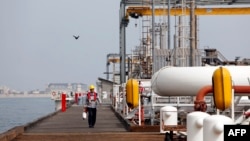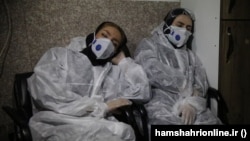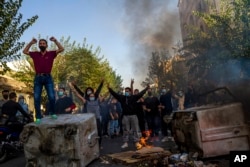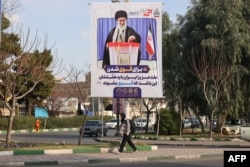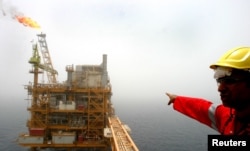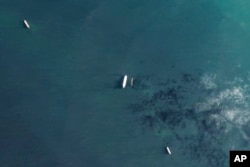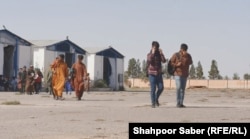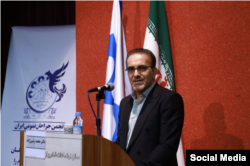Economy
Iran's Five-Day Workweek Campaign Pits Religious Identity Against Global Business
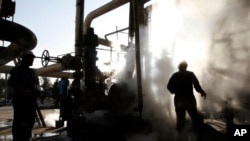
Iran has taken a big step toward reducing its number of working days and hours for government employees, a move that has long been sought as a way to improve labor production and economic efficiency.
But the effort was not without controversy, with parliament weighing strong opinions on which proposed new day off would be best -- Thursday, or Saturday.
Much of the debate in transitioning from a six-day workweek to five days has pitted business interests against religious values.
Proponents of adding a day off on Saturday say it would provide economic benefits and be more in keeping with the rest of the working world. Opponents argue that adding a day off on Saturday would be damaging to Iran's unique cultural and religious identity.
When the dust settled, Saturday emerged victorious in parliament on May 15 by a vote of 136 for to 66 against, with three abstentions. From parliament the proposal will now head to the Guardians Council, which holds veto powers and determines whether proposed legislation fits with the Islamic republic's interpretation of Shari'a law.
The effort to overhaul and standardize Iran's workweek goes back decades, but has picked up steam in recent years. The official workweek consists of 44 working hours, with a half-day off on Thursday and a full day off on the Friday day of prayer and rest.
The government of former President Mohammad Khatami began lobbying for a change in the early 2000s, and the current push marks the seventh campaign since 2016. In 2018, a proposal reached parliament but failed to result in a vote.
Mahdi Ghodsi, an economist with the Vienna Institute for International Economic Studies, explains that the initiative has historically faced hurdles because the Islamic republic has sought to "be a role model" in the Muslim world, and has "never wanted to follow international norms."
The workweek debate, he told RFE/RL's Radio Farda, is "a case in point" of the clerical establishment's contrarian nature, and has significant repercussions on international business.
In most foreign countries, "banks are closed on Saturday and Sunday," Ghodsi said. "So naturally a country that has a Thursday through Friday weekend means it has no financial relations with the rest of the world for four straight days."
Industry and commerce representatives argued that point in the run-up to the vote, but faced stiff resistance from lawmakers and influential clerics who claimed that a Friday-Saturday weekend would be a concession to Judeo-Christian values followed in many foreign countries.
Ruhollah Harizavi, deputy head of the Islamic Propagation Organization, warned against "the consequences of following the 'infidel' lifestyle."
The Khorasan newspaper, a conservative outlet based in the holy Shi'ite city of Mashhad, noted that a day off on Saturday would coincide with the Jewish Sabbath.
The newspaper stressed the importance of protecting Islamic identity and values, and argued against cultural mixing that could take away from societal individuality.
"The issue is not just a day off, it is an issue of altering social order," the daily wrote.
Parliament was informed ahead of the vote that Ayatollah Javadi Amoli, a leading cleric, had not raised any objections to Saturday being a day off. But the proposed legislation still faces a stiff test before the Guardians Council, the powerful constitutional watchdog dominated by hard-liners.
"The Guardians Council is more conservative, so they may reject the bill because they might think having Saturday off is a Jewish thing, which is baseless," Ghodsi said. "Other Muslim nations have Saturday off."
Turkey, for example, has both Saturday and Sunday off, while the United Arab Emirates has a half day off on Friday as well as Saturday and Sunday off. Saudi Arabia has Friday and Saturday off, in line with the position of the Organization Of Islamic Cooperation.
If the measure gets final approval, it will also cut the number of weekly working hours from 44 to 40.
Fewer working hours would also address another area where Iran has traditionally gone against the grain, with some arguing that achieving higher productivity requires more working hours, not fewer.
Ghodsi says that low production and efficiency has been a problem for years in Iran, but that it has "little to do with working hours" and is "rooted in a lack of financial resources and technology."
"Nevertheless, reducing working hours is a positive thing," Ghodsi said, noting that some countries were even adopting 35-hour workweeks.
"Fewer working hours means workers have more time to themselves, making them happier," Ghodsi said. "Working fewer hours could result in workers focusing more on finishing their tasks, which could increase efficiency."
While many Iranian listeners of Radio Farda appeared to be in favor of the proposed changes, not all were convinced it would have much of an effect considering the high levels of poverty, unemployment, and inflation in the country.
"Whether it is Thursday or Saturday it is not going to affect people's lives, because every day our lives are difficult," one listener called in to say.
Written by Michael Scollon based on reporting by RFE/RL's Radio Farda
- By Kian Sharifi
Why Are U.S. Sanctions Against Iran's Oil Exports Ineffective?
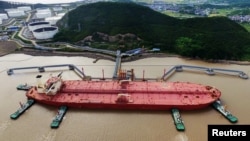
Iran is one of the most sanctioned countries in the world. But restrictions imposed by the United States have largely failed to stymie Iran's oil exports, the backbone of its flailing economy.
U.S. sanctions have cut off Iran from most of its traditional customers, forcing Tehran to find new buyers and sell its oil at discounted prices.
But China’s willingness to buy record amounts of Iranian oil, Tehran's mastery of sanctions-evading tactics, and Washington's reluctance to strictly enforce sanctions have made U.S. measures against Iran’s energy exports ineffective, analysts say.
'Dark' Fleet Of Tankers
The lifting of U.S. sanctions as part of the 2015 nuclear deal with world powers allowed Iran to sell its oil to customers in Europe and East Asia. Oil exports reached a peak in 2018.
But exports plummeted after then-President Donald Trump reneged on the nuclear agreement later that year.
Iran has boosted its sales in recent years by circumventing sanctions, including using its "dark fleet" of tankers to illegally transport oil shipments to China.
The tactic involves ship-to-ship operations to offload the oil, middlemen, hidden money transfers, and rebranding the oil to mask its Iranian origin and make it appear to come from a third country.
"Iran is continuously developing and expanding not just the network of middlemen and trading companies involved in the sale of its oil, but also its own fleet of tankers that it predominantly uses to move its crude," said Nader Itayim, the Middle East editor at the U.K.-based Argus Media.
Chinese Appetite
Growing demand for Iranian oil in China has been key to the surge in Iran's oil sales.
Ship tracking data collected by Argus shows Iran’s oil exports currently hovering at 1.5 million barrels per day, with around 85 to 90 percent going to China.
Tehran gives China a steep discount to take its banned oil, taking up to 15 percent off the price of each barrel to make it worthwhile for Beijing to take on the liability of skirting sanctions.
The discounts have raised questions about the long-term profitability of Iran’s business with China. But experts said that Tehran still stands to gain.
"Even at heavy discounts, selling Iranian oil is extremely profitable and sustainable," said Steve Hanke, a professor of applied economics at Johns Hopkins University. "That’s because the marginal cost of production in Iran is roughly $15 or less per barrel."
Gregory Brew, an Iran and energy analyst at the U.S.-based Eurasia Group, says U.S. sanctions were once effective at blocking oil exports to China, but that is no longer the case.
"China's rising stature as a new global power lends it greater freedom to defy U.S. sanctions," Brew said.
Reluctance To Enforce Sanctions
Some analysts said Washington has been reluctant to strictly enforce sanctions, while others maintain that sanctions in general have failed.
Resources are required to enforce restrictions while new sectors would need to be sanctioned to keep up the pressure, according to Itayim of Argus Media.
"Otherwise, the target finds ways to evade the sanctions, while at the same time the buyer becomes more complacent as it sees enforcement waning. In the case of Iran and China, I think we have seen a bit of both," Itayim said.
Analysts also argue that Washington is reluctant to strictly enforce sanctions due to the risks associated with forcing Iranian oil off the world market.
"Apart from the impact such action would have on the price of oil, which carries political and economic importance to [U.S. President Joe] Biden in an election year, aggressive enforcement would provoke both Iran and China, at a time when the United States is trying to manage escalatory risk both in the Middle East and East Asia," Brew said.
The lax enforcement of oil sanctions also extends to Venezuela and Russia, Itayim says, noting that it "has been key to keeping a lid" on oil prices.
U.S. Congress last month passed a security package that included the Iran-China Energy Sanctions Act, giving the government the authority to further restrict Iran's oil exports.
But experts are not convinced that more sanctions will have an impact.
Hanke said any new measures "will join the long list of failed Western sanctions" on the Islamic republic.
"Sanctions are always subject to workarounds that render the enforcement of sanctions futile," he added.
- By RFE/RL's Radio Farda and
- Kian Sharifi
Overworked And Underpaid, Many Iranian Doctors Migrate -- And Some Even Take Their Lives

The alarming number of young Iranian doctors taking their own lives has put the future of the country's health-care system in doubt.
Overworked, underpaid, and "humiliated" by their seniors, many resident doctors -- medical school graduates in training -- are harboring suicidal thoughts or considering moving abroad.
"Suicide among residents today is more of a crisis," Nima Shahriarpur, an emergency medicine doctor, told the Iranian news website Khabar Online.
And he may have a point: 16 resident doctors committed suicide in the Iranian year ending on March 19. A year earlier, 13 young physicians took their own lives.
The most recent incident happened last week, when Parastu Bakhshi was found dead by her colleagues at her hospital residence. The 34-year-old resident doctor was reportedly under increasing pressure at work.
Difficult Years
The residency period starts after medical school and lasts between three and five years. For some it starts tough. For others it is even more difficult.
Resident doctors, most of whom are in their 30s, are expected to work 30-hour shifts and are paid between 80 million and 110 million rials ($125 to $172) per month. The payments are often delayed.
The doctors are not allowed to practice medicine outside of the hospital during their residency and often have to work a second job in a different field to make ends meet.
A resident doctor who spoke to RFE/RL's Radio Farda on condition of anonymity said young physicians are subjected to poor working conditions, such as putting up with their supervisors' "humiliating behavior" and "bad language," while also being forced to work extra shifts.
According to Vahdat Shariat, the head of the Iranian Psychiatric Association, 30 percent of resident doctors in Iran consider committing suicide.
In September, Shariat and Hamid Yaqubi, the head of the Iranian Scientific Society for Suicide Prevention, urged the health minister to take action.
In a letter, they cited a study that found that 25 percent of resident doctors in Tehran suffered from severe depression.
They also suggested several measures to address the problem, including reducing excessive shifts, providing insurance for resident doctors, reviewing their salaries, and offering mental health support.
In recent years, resident doctors have sought to raise awareness of their plight on social media by posting images of their colleagues who committed suicide. While this has grabbed the media's attention, there has been no official response.
Not Easy To Quit
It was even very difficult to quit, until recently.
To be allowed into a residency program, medical school graduates needed two people to guarantee they would not leave the country or quit the program in any way -- including death by natural causes. Otherwise, the guarantors would have to pay damages.
That rule was deemed illegal and struck down in 2021, but residents say they are still asked to provide guarantees. A pharmacy resident, for instance, was asked to provide a guarantee worth 9.9 billion rials (over $15,500) just to travel abroad for holidays last month.
The financial guarantees make it difficult for doctors, particularly residents, to leave the country. But reports in Iranian media suggest doctors are leaving in droves.
The economic daily Donya-e Eqtesad reported last year that 5,000 doctors had emigrated from Iran in the Iranian year ending in March 2022, around 2,000 more than in 2020.
Citing a survey published in January 2023 by the state-funded Iranian Migration Observatory (IMO), local media say 50 percent of doctors surveyed sought to leave Iran. One-third of those said they were willing to take less-specialized jobs abroad unrelated to medicine.
The most popular destinations for Iranian doctors and nurses are Western nations, particularly the United States, and Persian Gulf countries.
A December 2022 IMO report showed that as of 2018, some 29,000 Iranians worked in the U.S. health-care system, including 8,000 physicians and surgeons. The overall number of Iranian health-care workers in the United States increased to 36,000 by 2021.
A survey published in Iran's state-run IRNA news agency last year found that many doctors start planning to leave the country in their 20s while in medical school.
"Interns see the residents' situation up close and know why they are unhappy," the report said. Among other reasons cited for their desire to leave were Iran's poor economic conditions and a poor work-life balance.
Nevertheless, little has been done to help resident doctors.
In a letter to Iranian President Ebrahim Raisi in January, Psychiatric Association chief Shariat warned that if officials continue to ignore the plight of young physicians, the country will have to contend with the "collapse of the health-care system."
Workers Still 'Drowning' Despite Iran's Minimum-Wage Hike

The Iranian government’s 35.3 percent hike in the minimum wage for workers, announced at the start of the Persian New Year, has sparked a backlash among labor activists and the country’s labor force, who say it is inadequate in the face of years of economic decline and falling living standards.
The wage hike was sanctioned by the Supreme Labor Council and ratified by representatives of the government and employers but not labor delegates, who showed their disapproval by walking out of the council meeting and refusing to endorse the decree.
"Being underwater economically, whether by a little or a lot, doesn’t change the fact that you are drowning," Alireza Mirghafari, a council member and labor activist, was quoted by the semiofficial ILNA news agency as saying.
Labor analysts say the hike, made on the eve of the Persian New Year, won’t stop a rise in poverty levels among the workforce given the annual inflation rate for the past five years has been above 40 percent amid stagnant wages, decimating purchasing power for much of the country.
The country's economy has been ravaged by U.S. sanctions, hitting budget revenues hard while also leading to a surge of protests. Labor Ministry data shows that Iran's poverty rate doubled in 2021, with one-third of the population living in "extreme poverty." Since then, conditions have failed to improve.
Meanwhile, in September 2023, Iran's Misery Index, calculated by the Iranian Statistics Center, rose to 60.4 -- its highest point ever and more than double what it was six years ago. The higher the rating, the worse off people feel.
The situation surrounding price growth is only going to get worse, according to Hassan Sadeghi, the head of the Veterans' Union of the Labor Community. He says the inflation rate could be on its way to climbing as high as 67 percent.
The wage hike decision has also prompted calls for heightened labor activism, with organizations like the Haft Tappeh Sugarcane Workers' Syndicate labeling the increase "humiliating" for workers. The syndicate, through a Telegram statement, has urged for continuous protests and strikes to fight for fair wages.
Further criticism has come from the Syndicate of Workers of the Tehran and Suburbs Bus Company, which said the new wage was still “insufficient” and called for collective action and the establishment of independent labor organizations as a means to defend workers' living standards.
A consortium of labor groups, including the Haft Tappeh Sugarcane Workers' Syndicate and the Retirees' Union, issued a joint statement emphasizing the importance of organized, strategic opposition to combat what they perceive as an exploitative system.
Unrest -- including several protests by teachers -- has rattled Iran in recent years in response to declining living standards, wage arrears, and a lack of welfare support.
Labor laws in Iran do not recognize the right of workers to form independent unions.
Written by Ardeshir Tayebi based on an original story in Persian by RFE/RL's Radio Farda
Iran's Medical Council Warns Of Doctor Shortage Due To Emigration

Iran's Medical Council in a March 16 report warned that the country is facing a shortage of doctors, especially pediatric surgeons, because of the increasing number of physicians emigrating from the country. The nongovernmental organization's report cited the ongoing economic crisis in Iran as a key reason for medical personnel choosing to leave. Mohammad Raiszadeh, head of the council, previously called the "emptying of physicians" a "serious" crisis and warned about the future of Iran's health sector. To read the original story by RFE/RL's Radio Farda, click here.
- By Kian Sharifi
Growing 'Despondency' And Hard-Liners' Dominance: Key Takeaways From Iran's Elections
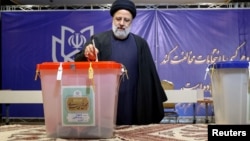
Iran’s parliamentary elections on March 1 witnessed a historically low turnout, in a blow to the legitimacy of the clerical establishment.
The official turnout of 41 percent was the lowest for legislative elections since the 1979 Islamic Revolution. Critics claim the real turnout was likely even lower.
Hard-liners dominated the elections for the parliament and the Assembly of Experts, a body that picks the country’s supreme leader, consolidating their grip on power. Many reformists and moderates were barred from contesting the polls.
Experts said the declining turnout signifies the growing chasm between the ruling clerics and Iran's young population, many of whom are demanding greater social and political freedoms in the Middle Eastern nation of some 88 million.
“These elections proved that the overriding imperative for the Islamic republic is strengthening ideological conformity at the top, even at the cost of losing even more of its legitimacy from below,” said Ali Vaez, the director of the Iran Project at the International Crisis Group.
'Widening Divide'
Observers said disillusionment with the state has been building up for years and is reflected in the declining voter turnout in recent elections.
Turnout in presidential and parliamentary elections were consistently above 50 percent for decades. But the numbers have declined since 2020, when around 42 percent of voters cast ballots in the parliamentary elections that year. In the 2021 presidential vote, turnout was below 49 percent.
Ali Ansari, a history professor at the University of St. Andrews, puts that down to growing “despondency” in the country.
This is “the clearest indication of the widening divide between state and society, which has been growing over the years,” said Ansari.
“It is quite clear that the despondency is extending even to those who are generally sympathetic to the regime,” he added, referring to reformist former President Mohammad Khatami choosing not to vote in the March 1 elections.
Voter apathy was particularly evident in the capital, Tehran, which has the most representatives in the 290-seat parliament. In Tehran, only 1.8 million of the 7.7 million eligible voters -- or some 24 percent -- cast their votes on March 1, according to official figures.
Up to 400,000 invalid ballots -- many believed to be blank -- were cast in Tehran alone, a sign of voter discontent.
Ahead of the elections, nearly 300 activists in Iran had called on the public to boycott the “engineered” elections.
Beyond Boycott
The March 1 elections were the first since the unprecedented anti-establishment protests that rocked the country in 2022.
The monthslong demonstrations, triggered by the death in custody of a young woman arrested for allegedly violating Iran’s hijab law, snowballed into one of the most sustained demonstrations against Iran’s theocracy. At least 500 protesters were killed and thousands were detained in the state’s brutal crackdown on the protests.
Iran has been the scene of several bursts of deadly anti-establishment protests since the disputed presidential election in 2009. Many of the demonstrations have been over state repression and economic mismanagement.
But experts said that the 2022 protests alone did not result in the record-low turnout in the recent elections.
“This is a reflection of a deeper malaise that extends back to 2009 and traverses through 2017, 2019, and 2022,” Ansari said. “It has been building for some time.”
Despite the historically low turnout, Supreme Leader Ayatollah Ali Khamenei praised the “epic” participation of the public. State-run media, meanwhile, spun the elections as a victory over those who called for a boycott.
By claiming victory, the clerical establishment “overlooks the growing absence of support from 60 percent of its population,” said Vaez.
“Such self-approbation [mirrors] the regime’s previous dismissal of the 2022 protests as the result of foreign intrigue rather than reflection of deep discontent,” he said, adding that it represents the Islamic republic’s “continuation of ignoring simmering public discontent.”
Hard-Line Dominance
Around 40 moderates won seats in the new parliament. But the legislature will remain dominated by hard-liners.
The elections were largely seen as a contest between conservatives and ultraconservatives.
“We can say that a more hotheaded and previously marginal wing of the hard-liners scored a victory against more established conservatives,” said Arash Azizi, a senior lecturer in history and political science at Clemson University in South Carolina.
“This is because the former had a more fired-up base and in the absence of popular participation were able to shape the results,” he added.
A more hard-line parliament could have more bark but “certainly” not more bite than its predecessors, according to Vaez.
“The parliament is subservient to the supreme leader and rubber stamps the deep state's strategic decisions, even if grudgingly,” he added.
Since the ultraconservative Ebrahim Raisi, a close ally of Khamenei, was elected as president in 2021, Iran’s hard-liners have dominated all three branches of the government, including the parliament and judiciary.
Other key institutions like the Assembly of Experts and the powerful Guardians Council, which vets all election candidates, are also dominated by hard-liners.
“There is not much left of the system's republican features,” Vaez said. “The Islamic republic is now a minority-ruled unconstitutional theocracy.”
Iran Cracks Down On Calls For Election Boycott
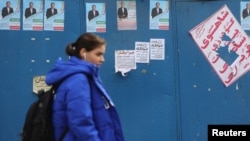
Several people have been detained in Iran for allegedly calling for a boycott of parliamentary and Assembly of Experts elections scheduled for March 1.
A young woman was arrested on February 28 for "opposing electoral participation" in Tehran's Valiasr Square during an event called "Free Tribune," witnesses told RFE/RL's Radio Farda.
They said the woman estimated to be in her 20s protested in front of a state television camera, symbolically removing her head scarf while declaring, "Vote or no vote, we will not vote."
A street vendor, who claimed to have witnessed the event, said the woman was quickly surrounded and subsequently detained by several security personnel after she waved her scarf over her head in protest.
Other eyewitness accounts detailed the intervention of two female officers, who covered the young woman with a chador cloak, while five male officers forcibly escorted her to a van.
The woman, described as having dyed, long hair and a slim build, was reportedly shouting for the officers to release her. Security forces present at the scene issued warnings to bystanders not to film the arrest and to disperse.
Elections for the parliament, the Majlis, are scheduled for March 1 along with voting to fill the Assembly of Experts, with a majority of would-be candidates already disqualified.
Many Iranians have said they will not vote in what they said will be "meaningless" elections that are likely to consolidate the power of the country's hard-liners.
U.S. State Department spokesman Matthew Miller said Iran's elections could not be considered free and fair.
"I suspect that a great number of Iranians have no expectation that those elections will be free and fair," Miller told reporters at the State Department on February 29.
"As you probably already know, thousands of candidates were already disqualified in an opaque process and the world has long known that Iran's political system features undemocratic and nontransparent administrative, judicial, and electoral systems.”
In the lead-up to the election, "Free Tribunes" have been organized by student groups in Tehran, where sentiment against the elections has spilled out.
Similar events have taken place -- in public and online -- in several areas of the country.
In the West Azerbaijan Province, police chief Rahim Jahanbakhsh announced the arrest of 50 people responsible for managing social-media pages that authorities say incited public unrest and discouraged election participation.
The arrests, Jahanbakhsh noted, were conducted in coordination with judicial authorities, though the identities of those detained remain undisclosed.
Jahanbakhsh also warned that publishing any content deemed provocative on social media would be considered a criminal offense.
Supreme Leader Ayatollah Ali Khamenei has tried to push the importance of high voter turnout in the elections after more than a year of unrest that had boosted growing skepticism over the efficacy of participating in the electoral process.
Independent polling on electoral participation is restricted in Iran, with government-conducted surveys rarely made public.
However, a leaked poll from a state-affiliated center suggested a mere 30 perecnt of voters may turn out for the upcoming elections, a figure that was swiftly retracted from publication. In the previous parliamentary elections in 2020, voter turnout was reported at a historic low of approximately 42.6 percent.
Prominent figures, including Nobel Peace Prize laureate Narges Mohammadi, have said openly they will boycott the elections, calling them superficial and predetermined. Similarly, Mostafa Tajzadeh, a former deputy interior minister, has voiced his refusal to vote, criticizing the supreme leader's indifference to the country's crises.
The elections also mark the first balloting since the widespread "Women, Life, Freedom" protests, ignited by the 2022 death of Mahsa Amini while in custody of the morality police. The protests led to a heavy-handed response from the government, including widespread arrests and crackdowns on demonstrators. At least 500 protesters were killed.
Written by Ardeshir Tayebi based on an original story in Persian by RFE/RL's Radio Farda
Ahead Of Iran's Elections, A Common Refrain: What's The Point?
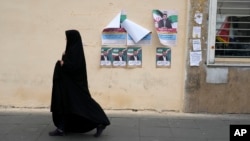
As Iran heads to the polls on March 1, there is a common thread running through many messages from ordinary Iranians.
The elections will usher in a new parliament and Assembly of Experts, a body that picks the country's supreme leader.
But in dozens of audio and written messages sent to RFE/RL's Radio Farda from inside Iran, many people said they will not vote in what they said will be "meaningless" elections that are likely to consolidate the power of the country's hard-liners.
The sample -- although small -- underscores the challenge to the legitimacy of Iran's ruling clerical establishment, amid rising anti-regime sentiment seen most vividly in the unprecedented street protests that rocked the country in 2022.
"You are not people's representatives," an Iranian man said in an audio message. "You want people only for their votes and nothing else. Then you want nothing to do with the people and they are cast aside."
Another man urged people not to vote for a "corrupt regime that has no place in ancient and civilized Iran."
"Isn't it time to say no to executions, dictatorship, and the occupation of my homeland, Iran?" added the man in an audio message sent to Radio Farda.
The authorities in Iran do not tolerate any form of dissent and have jailed scores of reporters, activists, and lawyers in recent years.
Around 700 prisoners were executed in Iran in 2023, alone, including nine protesters, according to human rights groups.
During the state's brutal crackdown on the months of nationwide protests that erupted in September 2022, at least 500 protesters were killed and thousands were arrested.
The protests began as a rebuke against the brutal enforcement of the hijab, a key pillar of the Islamic republic. But they soon snowballed into one of the most sustained demonstrations against Iran's theocracy, with some protesters calling for an end to clerical rule.
"Today we see that whoever criticizes the clerical dictatorship...is killed, injured, tortured, or imprisoned," said another man in an audio message sent to Radio Farda.
Those who sent audio and written messages to Radio Farda from inside Iran did not reveal their names or locations for fear of retribution.
Calls For Boycott
Scores of prominent Iranians outside the country and political and civil activists in Iran have called for a boycott of the March 1 voting.
Almost 300 political, social, and cultural figures in Iran on February 25 publicly denounced the upcoming vote, calling for people to follow suit and not participate in the "engineered" and "staged" balloting.
A day earlier, imprisoned Iranian human rights lawyer and Nobel Peace Prize winner Narges Mohammadi urged a boycott alongside "national sanctions and global condemnation" of the elections, calling the moves "a political necessity and a moral duty."
Iranian officials and state-run media have accused those calling for a boycott of doing the "enemy's" bidding.
Officials have repeatedly called on eligible voters to cast their ballots in the elections, calling it a religious duty.
The calls have come amid fears of a repeat of the record-low turnouts in the 2020 parliamentary elections and the 2021 presidential vote. Given the widening gulf between the ruling clerics and Iran's young population as well as ongoing state repression and economic mismanagement, the authorities are bracing for another poor turnout, according to experts.
"The elections are meaningless," said a man in another audio message sent to Radio Farda, in reference to what is seen as the grossly unfair playing field in elections in Iran, where candidates are vetted by a hard-line body whose members are directly or indirectly chosen by the supreme leader.
"Taking part in the elections, even if we're indifferent toward all the crimes that have been committed [by the state] in recent years, would only be a mockery of ourselves," the man added.
In another audio message, a man said he "hoped people's patience has run out" and they will not take part in the elections.
This is the only way, he said, to "end this miserable, sad, and poverty-stricken life."
Written by Kian Sharifi based on reporting by RFE/RL's Radio Farda
Scores Of Prominent Iranians Call For Boycott Of 'Staged' Elections
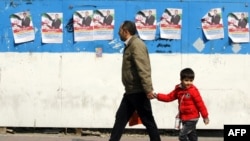
Almost 300 political, social, and cultural figures in Iran have publicly denounced the country's parliamentary and Assembly of Experts elections, calling for people to follow suit and not participate in the "engineered" and "staged" balloting.
"The half-hearted position and status of the institution of elections" in Iran has "reached a more deplorable situation, even compared to the previous elections," the group of 275 people, including Morteza Alviri, Abdolali Bazargan, Alireza Rajaei, Ali Babachahi, Alireza Alavitabar, and Abolfazl Ghadiani, said in a statement on February 25.
Elections for the parliament, the Majlis, are scheduled for March 1 along with voting to fill the Assembly of Experts, with a majority of would-be candidates already disqualified.
The statement highlighted the extent of the disqualifications of candidates for the 12th round of elections to the Majlis and said the "deadlock of reforms" points to a deepening crisis within the country's political landscape.
The signatories rejected justifications by some who say that Iranians should still participate even in what is seen as a flawed electoral process, saying that the previous policy of encouraging participation at any cost to push out the Islamic republic's leaders has not only been fruitless, but in fact contributed to the perpetuation of authoritarianism and political stagnation.
Emphasizing the dire state of Iran's current electoral institution, the activists outline a series of prerequisites for holding genuine, fair, and healthy elections.
These include the demand for freedom of speech, for the activities of opposition parties and associations, for the press and media, and the oversight of independent and impartial bodies on election procedures and outcomes.
The activists said those conditions aren't present in the upcoming elections, and therefore they "deem it necessary not to participate in the upcoming elections, which are clearly engineered against the public's sovereignty, and not to give in to this staging."
The statement also warns that without a genuine revival of the institution of elections, real participation in Iran's political process is "unattainable," drawing a bleak comparison to the fate of Lake Urmia, once the largest lake in the Middle East, that has now shrunk to one-10th of its original size.
Written by Ardeshir Tayebi based on an original story in Persian by RFE/RL's Radio Farda
Majority Of Iranians Shunning Workforce Amid Rise In Discontent

Almost six out of every 10 Iranians are neither employed or seeking work, while more than half of those who are employed also hold down a side job.
Ghasem Rostampor, the director-general of entrepreneurship and employment planning at the Labor Ministry, told the Tasnim News Agency that 58.5 percent of the country's population is considered inactive, which refers to individuals over the age of 15 who neither have a job nor are looking for one, a sign some analysts say shows the disaffection among younger Iranians with the current regime amid a crackdown on protests over the death of 22-year-old Mahsa Amini in September 2022.
The data contradicts claims by President Ebrahim Raisi's government that it has reduced the unemployment rate to 7.6 percent.
Details from data from the Statistical Center of Iran appear to show that the decrease in the unemployment rate is due to an increase in the country's inactive population instead of a surge in employment opportunities through government job-creation programs.
According to the Statistical Center, the number of active individuals -- those who either have jobs or are looking for work -- has decreased by 520,000 over the past four years, even though the population of those over 15 years of age grew by 2.9 million.
That means that since 2018 about 3.4 million people have given up looking for work and have joined the inactive population segment, the data shows.
The government's unemployment rate is a ratio of unemployed individuals to the country's active population, thus leaving out a large segment of Iranians who are of working age.
The Parliamentary Research Center recently warned about the rise in the inactivity rate of Iran's workforce, especially among younger Iranians. It says the real unemployment rate in the country is about 2.5 times higher than the government's statistics show.
Further distorting the government's data is the fact that official statistics include as employed those who work only one hour a week. Among the 24.8 million employed individuals in the country, 2 million are considered underemployed as they work less than 44 hours a week.
Another growing issue, Rostampor said, is that many those individuals listed as employed do not have formal contracts, thus depriving them of many benefits.
In September 2023, Iran's Misery Index, calculated by the Iranian Statistics Center, rose to 60.4 -- its highest point ever and more than double what it was six years ago. The higher the rating, the worse off people feel.
The index is also seen as a barometer for societal issues, with a direct link to crime rates and even instances of suicide. The most recent index also showed that in the past year, 22 of Iran's 31 provinces reported a reading surpassing the national average, highlighting countrywide discontent.
Several protests have been held by Iranians over the past year in response to declining living standards, wage arrears, and a lack of welfare support.
The death of Amini while in police custody for allegedly wearing a head scarf improperly has added fuel to the unrest, as Iranians have also demonstrated gainst a lack of freedoms and women's rights.
Written by Ardeshir Tayebi based on an original story in Persian by RFE/RL's Radio Farda
- By Reuters and
- Neil Bowdler
How Is the Red Sea Crisis Affecting Shipping And The World Economy?
With Huthi rebels disrupting shipping off the coast of Yemen and in the Red Sea, what impact is this having on shipping, trade, and the world economy? Thomas Juneau is an associate professor of public and international affairs at the University of Ottawa in Canada while Professor Steve Hanke is an economist at Johns Hopkins University in the United States.
Iranian Economy Buoyed By 'Dark Fleet' Oil Shipments To China
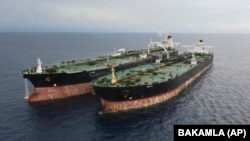
More than 6,000 kilometers from Tehran, in treacherous waters off the shores of Singapore, a "dark fleet" of oil tankers waits to offload the precious cargo that helps keep Iran's economy afloat -- a dependency that could also sink it.
The fleet has grown steadily over the past five years, delivering Iranian crude to China as the countries work in concert to circumvent international sanctions that target Tehran's lucrative oil exports. But while the clandestine trade has buoyed Iran's budget, it also comes at tremendous cost and risk to Tehran.
Iran gives China a hefty discount to take its banned oil, taking 12 to 15 percent off the price of each barrel to make it worthwhile for Beijing to take on the liability of skirting sanctions, according to research by the data analysis unit of RFE/RL's Radio Farda.
Additional costs add up as well: ship-to-ship operations to offload the oil, middlemen, hidden-money transfers, and rebranding the oil to mask its Iranian origin and make it appear to come from a third country, said Dalga Khatinoglu, an expert on Iranian energy issues.
Altogether, said Khatinoglu, who contributes to Radio Farda's data analysis unit, Iran's budget figures and official statements indicate that 30 percent of the country's potential oil revenue was wasted last year.
And with the draft budget for the next fiscal year currently being debated by the Iranian parliament, there are no guarantees that Tehran's bet on quenching China's thirst for oil will continue to be a panacea.
With Iran almost entirely dependent on Beijing to take its oil and on other entities to facilitate the trade, Tehran has managed to inject desperately needed revenue into its economy. But Iran has also put itself at risk of seeing its main revenue stream dry up.
"There's definitely an extent to which Tehran has become more dependent on the likes of China or those who would be willing to deal with Iran in spite of Western sanctions," said Spencer Vuksic, a director of the consultancy firm Castellum, which closely tracks international sanctions regimes.
Vuksic said Iran is "definitely put in a weak position by having to depend on a single external partner who's willing to deal with and engage with Tehran."
Oily Deficit
Iran has trumpeted its foreign trade, claiming in December that oil revenue had contributed to a positive trade balance for the first eight months of the year.
But the oil and gas sector, by far the largest part of the Iranian economy, will not be enough to save the current budget of around $45 billion that was approved last year.
The Iranian fiscal year, which follows the Persian calendar and will end in March, is expected to result in a major deficit. In presenting the draft budget to parliament in December, President Ebrahim Raisi acknowledged a $10 billion deficit.
But the shortfall could be much higher -- up to $13.5 billion, the largest in Iran's history -- by the end of the fiscal year, according to Radio Farda. This is because data shows that just half of the expected oil revenues were realized, in part due to lower than expected oil prices and additional costs and discounts related to Tehran's oil trade with China.
Whereas the budget expectations were based on oil being sold at $85 per barrel, the price of crude dipped below $75 per barrel in December and has fluctuated wildly recently amid concerns that tensions in the Middle East could disrupt shipping and production.
And while Iran expected to export 1.5 million barrels of oil per day (bpd), it exported only 1.2 million bpd in the first eight months of the year, according to Radio Farda.
Altogether, Radio Farda estimates that Iran lost some $15 million per day in potential revenue through its trade with China, which accounts for more than 40 percent of the Iranian budget.
For the upcoming budget of about $49 billion, expectations for domestic and foreign oil revenue have dipped by 3 percent, according to Khatinoglu, even as the projected budget itself has risen by about 18 percent.
Accounting for the fluctuation of global oil prices, which fell far short of the average estimated for the current year, the peg has been lowered to $71 per barrel. Tehran is also expecting lower oil-export volumes -- which only briefly met forecasts of 1.5 million bpd, the highest levels seen since 2018 -- with only 1.35 million bpd forecast.
Iran is reportedly expected to plug the gap left by the lower oil revenue by increasing taxes on wealthy individuals and businesses, while Khatinoglu says Tehran will try to boost revenue by raising domestic energy prices.
Shipping Competition
Adding to the uncertainty of Iran's finances is the potential for weaker Chinese demand for its oil and competition from Russia which, like Tehran, sends banned oil to Beijing.
And international sanctions are continuously evolving to punish countries and entities that foster Iran's illegal oil trade, threatening to capsize the dark fleet that helps sustain Tehran's so-called resistance economy.
On the other hand, the mercurial nature of oil price fluctuations and demand could work to Iran's advantage. With Venezuelan oil no longer under sanctions, Russia is left as the only competitor for clandestine oil sales to China.
And Iran's capacity to export oil is greater than ever, allowing it to more easily sell its oil to Beijing when demand is high.
This is largely due to the considerable expansion of the global "dark fleet" of oil since crippling U.S. sanctions targeting Iran's oil exports were restored after the United States unilaterally withdrew in 2018 from the Iran nuclear deal that has been agreed with six world powers.
The deal, known formally as the Joint Comprehensive Plan of Action (JCPOA), offered sanctions relief in exchange for curbs on Tehran's controversial nuclear program. After the deal went into effect in January 2016, Iran more than doubled its legal oil exports in a few months, eventually reaching a high of 1.54 million bpd in 2018.
But with the U.S. withdrawal from the deal and subsequent reintroduction of sanctions that year, Iranian oil exports plummeted. And after the exceptions granted to a handful of countries -- including China -- that were allowed to continue to import Iranian oil expired in 2019, Iranian oil exports slowed to a trickle.
This was partly because Iran was not equipped to export its oil and had no immediate customers willing to defy the sanctions. But that changed with the fine-tuning of Iran’s efforts to defy sanctions, the fivefold rise in the number of dark-fleet tankers, and China's willingness to take the risk of doing business with Tehran -- although Beijing has not acknowledged unregistered imports of Iranian oil.
Today the dark fleet of often aging ships -- nearly half of them VLCCs (very large crude carriers) -- has risen to up to 1,000 vessels, according to Vortexa, which tracks international shipping. Many smaller ships are involved in Russian oil exports, which account for about 80 percent of all opaque tanker activity. But Iran had access to nearly 200 tankers, many of them supertankers, as of early 2023, according to Vortexa.
More than 20 ships, 13 of them VLCCs, joined the Iranian fleet in 2023, Vortexa reported in June, contributing to record-high Iranian oil exports under sanctions.
Vortexa attributed the rise to increased Chinese demand, the addition of the new tankers to shuttle Iranian oil after many had switched to shipping Russian oil, and the decline of Iranian inventories drawn down to boost exports amid heightened competition with Russia for the Chinese market.
While Chinese demand for Iranian oil slowed in October, Vortexa noted in a subsequent report, Washington’s removal of oil sanctions on Venezuela that month opened the possibility of higher demand for Iranian oil.
Uncertain Waters
In an October report, the global trade intelligence firm Kpler explained that tankers illegally shipping Iranian oil commonly "go dark" upon entering the Persian Gulf by turning off their transponders, technically known as the automatic identification system (AIS). After visiting Iran's main oil terminal on Kharg Island or other ports, they then reemerge after a few days indicating they are carrying a full load.
From there, the ships offload the oil with ship-to-ship transfers that take place in unauthorized zones, mostly in the Singapore Straits. Eventually the oil, rebranded as coming from Malaysia or Middle Eastern countries, enters China, where it is processed by more than 40 independent "teapot" refiners that have little exposure to international sanctions or the global financial system.
Sanctions Revisited
The challenge for those trying to halt the illicit trade in Iranian oil as a way to hold Tehran accountable for its secretive nuclear activities and dire human rights record, is how to make the negatives of dealing with Iran greater than the financial benefits.
That has put the illicit seaborne trade of oil -- both Iranian and Russian, owing to the ongoing war in Ukraine -- under greater scrutiny by the international community.
"There's continuous refining of the sanctions programs to include and expand sanctions against those involved in evasion, and that includes sanctioning so-called dark fleets," said Castellum’s Vuksic, noting that the number of targeted sanctions against Iranian individuals and entities rose by more than 1,000 last year.
The big question is enforcement, an issue that is being debated in the United States and other countries and is leading to increased calls for countries like Panama to de-flag illegal tankers and for countries to clamp down on dark-fleet ships anchored off their shores.
"My expectation is that governments, including the United States, will take action against these dark fleets, especially the facilitators and the [ship] owners when they're identified," Vuksic told RFE/RL.
Other factors, including concerns about the impact of a broader Middle East conflict potentially involving Iran, could also hurt or help Iran's financial standing.
As Kpler noted while reporting that Chinese imports of Iranian oil had dropped significantly in October, the changing global landscape can have a big effect on the independent Shandong-base refineries that purchase Iranian oil.
"Middle East tensions/threat of stricter enforcement of U.S. sanctions may have turned Shandong refiners more risk-adverse," the global trade intelligence firm wrote in a post on X, formerly Twitter.
In the past week, supply fears also exposed the volatility of global crude prices, potentially to Iran's benefit.
Oil prices rose sharply on January 2 on news that Iran had sent a frigate to the Red Sea and was rejecting calls to end support for attacks by Tehran-backed Huthi rebels that have disrupted shipping in the important trade route.
Prices surged again following the deadly January 3 bombing attack in Iran, for which the Islamic State militant group has claimed responsibility.
But the week ended with questions about the future of Iran's cut-rate deal with the only country willing to help prop up its economy, with Reuters reporting that China's oil trade with Iran had stalled after Tehran withheld supplies and demanded higher prices.
Afghans Banned From 16 Provinces In Iran As Forced Exodus Continues
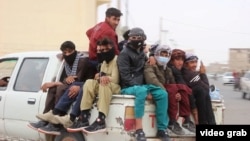
Iran has banned millions of Afghan refugees and migrants in the country from living in, traveling to, or seeking employment in just over half of the country's 31 provinces.
On December 3, Hamzeh Soleimani, the director-general of citizenship and foreign nationals affairs of the western Kermanshah Province, confirmed the ban was in place in 16 provinces nationwide.
"Numerous construction projects, greenhouses and livestock farms underwent inspection under the plan. [This led] to the arrest and expulsion of Afghan workers from the province," he said.
Iranian media have identified 15 of the 16 provinces, including Kermanshah, East Azarbaijan, West Azerbaijan, Ardabil, Zanjan, Kurdistan, Hamedan, Gilan, Mazandaran, Sistan-Baluchistan, Ilam, Lorestan, Chaharmahal and Bakhtiari, Kahgiluyeh and Boyer Ahmad, and Hormozgan.
In October, Iranian Interior Minister Ahmad Vahidi reiterated that Tehran would deport all "illegal" migrants, most of whom are Afghan nationals who fled war, persecution, and poverty.
Tehran estimates that more than 5 million Afghans currently live in the country. Iranian officials now want to deport at least half of them because they do not have the documents to remain in the country.
During the past few months, the rate of Afghans deported from Iran has steadily increased despite efforts by Afghanistan's Taliban-run government to persuade Tehran to give the Afghans more time before embarking on a mass expulsion campaign like Pakistan.
Islamabad is currently deporting thousands of impoverished Afghans daily as part of its campaign to expel more than 1.7 million "undocumented foreigners."
In Iran, Afghans say their life is becoming more complicated with each passing day.
"The situation of Afghan refugees across Iran is very worrying," Sharif Mateen, an Afghan refugee, told RFE/RL's Azadi Radio.
"Police are arresting everyone irrespective of whether they have documents or not. They are then taken to repatriation camps," he added.
WATCH: Despite risks to their safety, thousands of Afghans -- often undocumented -- flock into Iran to find work.
Iran has hosted millions of Afghans for more than four decades, but Tehran has often complained of the lack of international aid for hosting them.
More than 70 percent of the 3.6 million Afghans who left their country after the Taliban seized back power in August 2021 fled to Iran.
Data show most are educated, middle-class Afghans who served in the fallen pro-Western Afghan republic's security forces or civil bureaucracy.
- By RFE/RL's Radio Azadi and
- Will Tizard
Thousands Of Desperate Afghans Make Risky Journeys Into Iran To Find Work
Despite risks to their safety, thousands of Afghans -- often undocumented -- flock into Iran to find work. Laborers in the capital of Nimruz Province, Zaranj, told RFE/RL why they take these risks. The UN estimates 2.6 million Afghans live in Iran. Many fled their homeland to escape persecution and a grinding economic crisis after the Taliban seized power in 2021.
Tajik, Iranian Presidents Discuss Bilateral Ties In Dushanbe
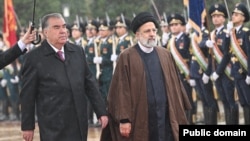
Tajik President Emomali Rahmon and Iranian President Ebrahim Raisi held talks in Dushanbe on November 8 to discuss bilateral ties, the Tajik presidential press service said. The two signed several documents, including an agreement on visa-free visits between citizens of the two countries, which share a common language, as well as memorandums of understanding on transportation, free economic zones, and joint efforts against illegal drug-trafficking. Raisi's visit was seen by many as a fence-mending move, as Tajik-Iranian ties have been frosty in recent years over Dushanbe's 2015 decision to ban the opposition Islamic Renaissance Party of Tajikistan. To read the original story by RFE/RL's Tajik Service, click here.
Iranian Official Says Lagging Oil Revenues Causing Budget Gap
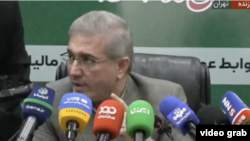
The head of Iran's Budget and Planning Organization says the government achieved only "around" 70 percent of its projected revenues for the first seven months of the current Persian calendar year, a rare admission of a significant state budget deficit.
Davod Manzor told a press conference on October 24 that the government also failed to meet its target of exporting 1.5 million barrels of oil daily, helping create the budget shortfall.
Addressing the reasons behind the shortfall, he refuted senior government officials' claims that Iran's daily oil exports had surpassed 1.8 million barrels and emphasized that the actual total of oil exports was "less than what was projected in the budget law."
Manzor pointed out that the budget had anticipated oil revenues based on an "overestimated" price of $80 per barrel and daily exports of 1.5 million barrels. However, in reality, the oil price remained "below $80 for most months in question" and due to domestic market demands, especially during the summer, daily oil exports were "less than 1.5 million barrels."
Another significant revenue gap was identified in the "income from the transfer and monetization of assets," which was projected to be one quadrillion rials ($2 billion). However, the actual revenue from this source in the first seven months was less than 100 trillion rials ($200 million), he said
Given these shortfalls, the total revenue realization stands "at just 70 percent," confirming a severe budget deficit for the government in the first seven months of the Persian calendar year, Manzor said.
While the total budget for the current year was set at 20 quadrillion rials ($40 billion), with expected revenues of 12 quadrillion rials ($24 billion) for the first seven months.
Government officials and the Ministry of Oil have not disclosed exact figures for Iran's oil exports. However, Oil Minister Javad Owji has said Iran would set a "new record in oil exports this year."
Iran's economy has been hobbled by Western sanctions over its human rights record and unrest has rattled the country since late last year amid declining living standards, wage arrears, and a lack of welfare support.
U.S.-Iranian relations have withered under a failure to revive a nuclear deal that President Joe Biden vowed to renew when he ran for president.
Negotiations aimed at reviving the 2015 nuclear deal between Iran and world powers remain deadlocked. In the absence of a deal Tehran has reduced its commitments to allow monitoring and provide further information on its nuclear program.
Written by Ardeshir Tayebi based on an original story in Persian by RFE/RL's Radio Farda
'I'm Afraid': Afghan Migrants Complain Of Rising Harassment, Violence In Iran
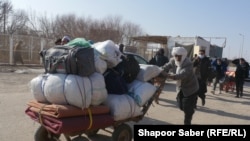
For decades, millions of Afghans fleeing war, persecution, and poverty have sought refuge in neighboring Iran.
Now, many of them face deportation after Tehran recently vowed to expel the 5 million Afghans it said were living "illegally" in the Islamic republic.
Afghan refugees and migrants say the September 27 announcement has triggered a surge in abuse against members of the sizeable Afghan community in Iran, including harassment and assault.
On October 6, a video posted on social media appeared to show a group of Iranian men and boys armed with sticks attacking the homes of Afghans in the northern city of Ghazvin. The authorities said 19 of the alleged attackers were arrested.
Other videos released in recent weeks, which RFE/RL was unable to verify, purportedly show groups of Iranian civilians beating up Afghans.
"We are worried that the situation in Iran has turned very hostile against Afghans," Parwana, an Afghan refugee who lives with her family in Tehran, told RFE/RL's Radio Azadi. "They are throwing stones at the windows of houses where Afghans live. They shout, 'Afghans should leave our country and return to their homeland,'" added Parwana, who only gave her first name.
Sweta, another refugee who lives in the Iranian capital, says she has also observed a recent surge in the number of physical and verbal attacks against Afghans. "I witnessed Iranians beating young Afghan boys publicly even when they hadn't done anything wrong," Sweta, who also only gave her first name, told Radio Azadi.
History Of Abuse
For years, human rights groups have documented widespread violations against Afghan refugees and migrants in Iran, including physical abuse, detention in unsanitary and inhumane conditions, forced payment for transportation and accommodation in deportation camps, forced labor, and forced separation of families.
Mired in an economic crisis amid skyrocketing inflation and rising food prices, Iran has often expressed alarm at the number of undocumented Afghans on its soil. Officials have often blamed Afghans for insecurity and unemployment in Iran.
Tehran has also complained that it has received little financial help from the international community, despite hosting millions of Afghans since the Soviet invasion of Afghanistan in 1979.
Iran's plans to deport undocumented Afghans also come amid its worsening ties with Afghanistan's Taliban rulers. Taliban militants have engaged in deadly clashes with Iranian border guards in recent months amid a dispute over cross-border water resources.
In a statement released on October 14, some 500 Iranian activists urged the authorities "not to exploit the country's current problems and drag us into the abyss of racism and hatred."
"Let's not allow people to sow seeds of hatred, violence, discrimination, and xenophobia," it said.
An estimated 3.6 million Afghans have fled their homeland since the Taliban seized power in 2021, with many fleeing persecution and the devastating humanitarian and economic crises plaguing the war-torn country.
Around 70 percent of them have moved to Iran, according to the United Nations, although hundreds of thousands have been deported.
The United Nations has said that more than 3 million Afghans live in Iran. Out of them, around 1.3 million have visas or refugee status. Tehran has claimed that a significantly higher number of Afghans live in the country.
Last week, Tehran said more than 1 million Afghan refugees registered for new biometric cards, giving them access to banking services and SIM cards.
Deportations
Iran has intensified the deportations of Afghans since announcing its plan to expel all undocumented migrants.
Local Taliban officials in Afghanistan's southwestern province of Nimroz say that Tehran has deported over 150,000 Afghans in the past three months.
Afghans who were recently deported told Radio Azadi that they were mistreated and harassed by Iranian border guards. "They did not give us bread or water during the two days that they imprisoned us," said Abdul Salam, who illegally entered Iran two months ago and found a job as a laborer in the southeastern city of Zahedan.
"They held us in a room and then took us outside," he added. "They left us in the scorching sun from morning to evening. We couldn't get up. When we stood up, they kicked us in the back."
Afghans who still reside in Iran say they live in constant fear of deportation or violence.
"I'm afraid to leave my home because many Afghans have been subjected to beatings in the markets and on the streets," an Afghan refugee who requested anonymity due to fears of retribution told Radio Azadi.
Written by Abubakar Siddique based on reporting by Naqiba Barekzai of RFE/RL's Radio Azadi
- By AP
Iran's President Says U.S. Should Ease Sanctions To Demonstrate It Wants To Return To Nuclear Deal

Iran’s President Ebrahim Raisi said on September 20 that relations with the United States can move forward if the Biden administration demonstrates it wants to return to the 2015 nuclear deal, and a first step should be easing sanctions. He told a news conference that the Americans have reached out through several channels “saying they wish to have a dialogue, but we do believe that it must be accompanied by action.” “So talk alone is not going to do it,” Raisi said. But action on sanctions can be “a solid foundation for continuing” discussions. The Iranian leader added: “We have not left the table of negotiations.” To read the original story by AP, click here.
As 'Misery' Rises In Iran, So Does People's Determination To Move Abroad
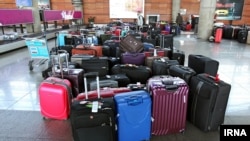
Iranians are more miserable than ever, according to recently released figures, at a time when a large segment of the population is reportedly considering leaving their country for good.
Iran's "misery index" stands at more than 60 percent, according to the latest quarterly study compiled by the government-funded Iranian Statistics Center. The index, which factors in inflation and unemployment figures and is seen as a predictor of everything from crime levels to economic stagnation, rose by 1.2 percentage points over the previous quarterly survey.
The misery index was highest -- 69.5 percent -- in the western Lorestan Province, which has seen violent protests over water shortages in recent years and has among the highest unemployment and inflation rates in Iran.
The increase comes amid a flurry of reports highlighting the government's concerns over the number of Iranians who want to emigrate in search of a better life abroad, resulting in loss of capital, professionals, and skilled workers.
"Confidential" internal correspondence purportedly from the Information Ministry suggested this week that a government survey had indicated that "young men of higher education and financial capabilities, particularly in big cities," were the most willing to leave Iran.
RFE/RL is unable to verify the accuracy of that and other documents leaked by the Qiyam Ta Sarnguni, a group affiliated with the banned Mujahedin-e Khalq Organization.
Another "confidential" document recently leaked by the group online, this time from the presidential office's Center for Strategic Studies and reportedly sent to Interior Minister Ahmad Vahidi, noted "a wide wave of [people] who desire to emigrate." The assessment, which traditionally does not account for medical workers who are known to seek careers abroad, was described as "an alarm" that signals the ineffectiveness of efforts toward "controlling the motives of immigration and indifference toward the country."
The brain drain of tech specialists, health-care professionals, and educators from Iran has been well documented in the past year, following a brief respite when many international sanctions were lifted on Iran under an historic nuclear deal signed with world powers.
But with the withdrawal of the United States from the deal in 2018, the agreement faltered and the return of crippling U.S. sanctions targeting key export industries has posed significant obstacles to Iran's already dire economic situation. Iranians have additionally struggled in recent years with soaring inflation and record unemployment.
Tehran's harsh response to protests across the country -- both by struggling industrial workers and farmers suffering severe water shortages in recent years, as well as supporters of the country's Women, Life, Freedom! movement who have voiced their anger at the clerical establishment -- appears to have pushed many Iranians to consider leaving for good.
An ongoing purge of academics at Iranian universities, government pressure on medical workers treating protesters injured in the brutal clampdown on dissent, and restrictions and Internet slowdowns on tech-savvy companies have all been cited as contributing factors to the latest round of brain drain.
Another document leaked by Qiyam Ta Sarnguni in August, this time allegedly from the Information Ministry, suggests that officials are seeking to prevent the "emigration of scientific and elite groups." The document also claims that the emigration of elite talent is "limited to the field of health treatment" and is due to the "intensification of economic and livelihood problems in the country."
The Farhikhtegan newspaper, the official mouthpiece for Tehran's Islamic Azad University, has said that 6,500 doctors and medical specialists left the country in 2022. And Mohammad Mirzabigi, the head of Iran's nursing system, told the semiofficial ILNA news agency recently that "between 100 and 150 nurses emigrate every month," according to RFE/RL's Radio Farda.
Injured protesters who spoke to Radio Farda have indicated that harassment against health-care workers has also led some to go abroad for treatment. "The main reason [for emigrating] was the treatment of my eye, because in Iran, doctors were under pressure [from the government], and I couldn't ask any more of them," Maysam Dehghani, a protester who sustained a severe injury at the hands of Iran's security forces, said this week.
There are also indications that the desire to leave the country is not unique to the elite.
In an interview with ILNA this summer, Daud Beginejad, the vice president of Iran's Real Estate Consultants Association, said that the flight of housing developers posed a "very dangerous" threat to Iran's future.
Half of Iran's university students and graduates have decided to emigrate -- accounting for more than 66,000 people, according to Bahram Salvati, the director of the Iranian Migration Observatory, a research institute based at Tehran's Sharif University that itself came under pressure in August after it was given an eviction notice.
Salvati has also cited Iran's unstable Internet, which the authorities have slowed or shut down amid protests, as a cause for start-up companies to leave for Turkey and other countries in the region.
The list of skilled workers seeking to emigrate goes on, including midwives, pilots, truck drivers, and construction workers.
Outside organizations have noted the impact, with the European Union's Agency for Asylum reporting this year that Iranian asylum applications to the EU had "more or less doubled" this year compared to the same period in 2022, with more than 13,000 applications.
Saeed Moaidfar, head of the Iranian Sociological Association, explained in a recent interview with the Jamaran news website the deep-seated "reasons behind people's" desire to emigrate.
"A migration wave occurs when a deep economic crisis in the field of production, employment, inflation, and other issues coincides with other crises," Moaidfar said. "It means, for example, that this person or persons have reached the point where their political system is not sufficient to overcome an economic crisis, or they feel that nepotism is used instead of meritocracy."
According to the Iranian Migration Observatory, about 2.2 million Iranians, accounting for some 3.3 percent of the population, left the country for work or other reasons last year. The vast majority -- 62 percent -- do not want to come back after leaving, with more than 90 percent saying they distrust the government's pledges of opportunities at home.
With neighboring countries experiencing rapid growth, Iranian officials are expressing fear that the country could become "an island devoid of opportunities."
Mehdi Ghazanfari, the head of the National Development Fund, said in a recent interview with an economic publication that the lure of life abroad could leave Iran without "manpower and opportunities" and that "the day will come" when the country will become a training center for other countries' workers.
Written by Michael Scollon based on reporting by RFE/RL's Radio Farda
Iranian Misery Index Hits New High As Unemployment, Inflation Rise

Iran's Misery Index, a calculation that combines unemployment and inflation rates, has risen to 60.4 percent, its highest point ever and more than double what it was six years ago.
The index, calculated by the Iranian Statistics Center and released on September 18, shows how the average citizen is faring economically.
The latest data, the center said, showed a 1.2 percentage point rise at the end of the first quarter, and in some provinces, such as Lorestan, the index reached almost 70 percent.
The index shows the depths to which Iran's economy has been ravaged by U.S. sanctions over Tehran's nuclear program.
In 2018, when then U.S. President Donald Trump pulled out of a global deal on Iran's nuclear program and reintroduced sanctions on Tehran, the Misery Index stood at 38.9 percent.
In response to declining living standards, wage arrears, and a lack of welfare support, Iranians have taken to the streets to protest living conditions and demand government action.
In Lorestan, the province's annual inflation rate was reported at 57.1 percent for the month of June, making it one of the highest among Iran's 31 provinces. Meanwhile, Lorestan's unemployment rate was 12.4 percent, the second-highest nationally.
The Misery Index showed provinces such as Chaharmahal and Bakhtiari -- both of which had readings in the high 60s -- aren't lagging far behind. Sistan-Baluchistan, which has the highest unemployment rate in the country at 12.8 percent, was also hard hit, the index shows.
The Tehran-based Donya-e-Eqtesad newspaper cited experts who underscored the importance of the Misery Index in gauging stagflation within an economy.
The index is also seen as a barometer for societal issues, with a direct link to crime rates and even instances of suicide. The publication highlighted that in the past year, 22 of Iran's 31 provinces have reported a Misery Index surpassing the national average.
The death in September 2022 of 22-year-old Mahsa Amini while in police custody for allegedly wearing a head scarf improperly has added fuel to the unrest, as Iranians demonstrate against a lack of freedoms and women's rights.
Written by Ardeshir Tayebi based on an original story in Persian by RFE/RL's Radio Farda
- By RFE/RL
Tehran Names Five Iranians For Looming Prisoner Swap With U.S., Says Americans 'In Full Health'
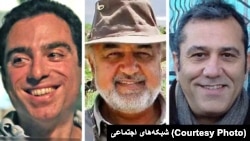
Iranian officials have identified five individuals in U.S. custody whom Tehran would like handed over as part of a possible 10-person, $6 billion prisoner swap initially said to have been mapped out last month between the longtime foes.
They include three Iranians -- Mehrdad Ansari, Reza Sarhangpour Kafrani, and Kambiz Attar Kashani -- charged with illegally obtaining advanced or potentially dual-use technology thought to be bound for Iran that has been under tightly reimposed U.S. sanctions since 2018. Two others -- Kaveh Lotfolah Afrasiabi and Amin Hasanzadeh -- were jailed for failing to register as a foreign agent and stealing engineering plans on behalf of Iran, respectively.
AP said Ali Karimi Magham, a spokesman for the Iranian mission to the United Nations, confirmed the five men's identities after the Al-Monitor website published their names.
The U.S. State Department has not officially commented on the Iranian list.
Previous reporting has identified three of the five individuals that the U.S. side wants in an exchange as two Iranian-American businessmen accused by Tehran of spying, Siamak Namazi and Emad Sharghi, along with similarly accused British-American environmentalist Morad Tahbaz.
Iranian President Ebrahim Raisi said on September 12 that the five U.S. citizens in Iranian custody who are expected to be part of the swap are "in full health," according to NBC as quoted by Reuters.
"They are very healthy and, according to our latest information, they are in full health," Raisi told Lester Holt of NBC Nightly News in an interview taped in Tehran on September 12, the U.S. television network said.
U.S. officials on September 11 confirmed that Secretary of State Antony Blinken had signed off on a sanctions waiver to allow billions in frozen Iranian assets to be transferred from South Korea to Qatar, presumably as part of the swap, and informed Congress of the plan.
Tehran had indicated earlier that it believed a swap was imminent, although it sought to decouple the asset handover from the prisoner deal.
The Biden administration has insisted in the face of Republican and other criticism that the assets involved are neither U.S. taxpayer dollars nor a ransom.
Critics argue that the freed-up assets could throw a lifeline to an Iranian economy buffeted by U.S. sanctions with Tehran continuing its belligerent behavior in the region.
"The money can only be used for humanitarian purposes and we will remain vigilant in watching the spending of those funds and have the ability to freeze them again if we need to," Reuters quoted State Department spokesman Matthew Miller as saying on September 12.
Iranian security forces have taken some 40 foreign nationals into custody during a current wave of unrest, often without revealing any charges.
Western countries have repeatedly said that Iran is trying to take advantage of foreign countries by taking dual and foreign nationals hostage to use in prisoner swaps.
Republican President Donald Trump unilaterally withdrew in 2018 from a three-year-old deal between world powers and Iran to curb Tehran's nuclear program in exchange for sanctions relief.
Aside from the diplomatic and economic fallout, observers since then have attributed a series of ship seizures and attacks in the crucial Strait of Hormuz region to Tehran.
The Pentagon is said to be weighing a plan to put U.S. troops aboard commercial ships in the region, which is a conduit for around one-fifth of all global oil shipments.
Tehran has also cooperated with Russia in the Middle East in addition to supplying Moscow with crucial attack drones to further the Kremlin's war plans in Ukraine.
Based on reporting by AP and Reuters
Six Iranian Miners Remain In Custody A Month After Protest
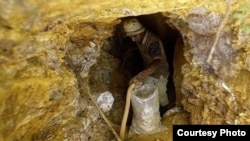
Six workers from the Agh-Dareh Vosta mines in West Azerbaijan Province have been held in detention since August 31, following union protests.
The Tehran-based Sharq newspaper reported on September 7 that 32 miners in total from the village of Agh-Dareh Vosta, near the northwestern city of Takab, were arrested during a protest last month sparked by demands for the employment of local residents in the region. All but six have been released.
The detained miners, who were employed in the gold and stone mines of Agh-Dareh, are currently being held in Urmia prison. They face charges including disrupting public order, acting against national security, and kidnapping. The context or specifics of the kidnapping charge remains unclear, as the newspaper did not provide further details.
The report also cited labor sources as saying that wages for July and August had not been paid to those miners from Agh-Dareh Vosta who participated in last month's protest. Additionally, several miners who were released on bail are being barred from returning to work.
Worker protests in Agh-Dareh, the country's second-largest gold mine, have made headlines several times in recent years.
In 2016, 17 gold miners from the area were sentenced to flogging on charges of disrupting public order.
Last month's protests by the miners of Agh-Dareh escalated into violence after police intervened.
Labor protests in Iran have been on the rise in response to declining living standards, wage arrears, and a lack of insurance. Labor law in Iran does not recognize the right of workers to form independent unions.
The government's response to the protests has been arrests, violence, and repression.
Written by Ardeshir Tayebi based on an original story in Persian by RFE/RL's Radio Farda
Iran Grapples With Exodus Of Health-Care Professionals
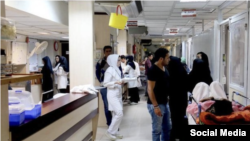
Sepideh, a middle-aged doctor, left Iran to benefit from the higher wages and better living conditions offered abroad.
After first moving to the Gulf state of Oman, the single mother recently relocated to Finland, where she lives with her child.
“The working conditions [in Iran] were difficult," Sepideh, who did not reveal her full name due to fears for the safety of her family in Iran, told RFE/RL’s Radio Farda.
"I didn’t have the [financial] security to send my child to a good school. They told my child things that I as a mother don't want [my child] to hear," she added, in reference to state schools that have been accused of promoting religious and ideological propaganda.
Sepideh is among the thousands of Iranian health professionals who have left their homeland in recent years, mainly due to the country’s deepening economic crisis, difficult working conditions, and the lack of social and political freedoms.
Iranian media outlets have estimated that some 16,000 doctors, including specialists, have left the Islamic republic since 2020, leading to warnings of a public health-care crisis.
The exodus accelerated after the coronavirus pandemic, which took a heavy toll on health-care workers. Iran was one of the worst affected countries in the world, recording over 146,000 deaths.
Doctors have also been targeted by the authorities for treating protesters during the nationwide antiestablishment demonstrations that rocked the country following the September 2022 death in custody of a woman who had allegedly violated Iran’s mandatory head-scarf law.
For Sepideh, her difficult decision to leave her homeland and extended family was mainly financial.
“Our salaries were not paid on time, and we had no recourse to complain about our working conditions," she said. "There was no job security, and the taxes were too high."
Sepideh said doctors have seen their livelihoods plunge in recent years due to soaring inflation and the declining value of the rial, Iran’s national currency. International sanctions and government mismanagement have crippled the Iranian economy, leading to rising poverty and unemployment.
“The salary you earn here [in Europe] is enough to live off,” she said. “You also have social freedoms here.”
Sepideh also said the authorities’ widening crackdown on women who violate the country’s draconian hijab law is driving some female doctors to leave their homeland.
"Many of my female colleagues were arrested over the hijab,” she said. “One was a gynecologist. All her clients were women, but she was arrested and interrogated by the Intelligence Ministry."
More women have defied the mandatory head scarf -- a key symbol of the Islamic republic -- since nationwide protests broke out over the violent enforcement of the hijab law and the lack of freedoms in the country. The state’s brutal crackdown on the rallies left at least 500 demonstrators dead.
Acute Shortage
Authorities said around 3,000 doctors, including 160 cardiologists, and some 800 nurses sought work abroad last year.
“This country is emptying of doctors,” Mohammad Raeeszadeh, the head of the Medical Council of the Islamic Republic of Iran, told a gathering of surgeons earlier this month.
He said that low wages have pushed Iranian doctors to look for “higher salaries” abroad, especially in the oil-rich Gulf states.
Officials have warned of an acute shortage of doctors, although it is unclear if the government has taken steps to stem the exodus. Some officials have suggested the country could look to attract doctors from abroad.
Iran has faced a severe brain drain since the Islamic Revolution in 1979, which brought to power the current clerical establishment. Estimates suggest that nearly 200,000 skilled professionals have left the country during the past four decades, with many resettling in the West.
Shahram, a specialist doctor, moved to Canada last year after seeing his livelihood diminish at home. He said he earned around $20,000 a year in Iran, although with soaring inflation and rising costs his standard of living had fallen dramatically in recent years.
"I was apprehensive about my professional future," Shahram, who only revealed his first name, told Radio Farda. “Doctors need support [from the government]. The lack of support is disheartening doctors.”
Sepideh said the loss of specialist doctors is particularly worrisome. "We are losing many specialists every year," she said. "They are the real treasure of our nation.”
Written by Abubakar Siddique based on reporting by Seyed Benyamin Sadr.
Rumors Of Gas Price Hike Sparks Long Lines At Iranian Gas Stations

Cars have formed long lines at gas stations in Tehran and several other Iranian cities amid growing rumors of a possible increase in fuel prices, which would severely impact consumers already battered by stagnant wages and rampant inflation.
Images on social media showed lines of cars stretching several blocks from some gas stations on August 16 with local media outlets attributing the chaos to "rumors of a fuel price hike."
The daily Etemad highlighted the congestion at one petrol station in Tehran, saying lines had already formed at 2 a.m.
Speculation about a fuel price increase intensified after comments by Ali Akbar Nejadali, head of the National Iranian Oil Refining and Distribution Company, regarding the "implementation of a filling limitation plan at petrol stations."
In addition, recent reports have suggested that a significant number of petrol stations in Tehran, Karaj, and other cities have been closed, sparking rumors of a fuel shortage.
Nejadali said in an interview with state television that the aim of the limitation plan was to "prevent the closure of gas stations" while at the same time insisting that "there is no shortage in fuel distribution across the country, and the fuel supply situation at stations is satisfactory."
Oil Minister Javad Oji also tried to play down the rumors, saying the government has no plans to increase fuel prices. Reza Navaz, the spokesperson for the National Petrol Station Owners Association said that there were no disruptions in fuel supply to the stations.
Having seen living conditions decimated by years of international sanctions, Iranians have become hypersensitive to price changes, and even rumors of an increase. Mistrust of government officials has compounded the fears.
In November 2019, despite persistent denials of any planned fuel-price hikes by officials, the authorities unexpectedly introduced price increases of up to 200 percent, sparking mass protests that saw thousands of Iranians in more than 100 cities and towns take to the streets. The protests quickly turned political, with many chanting anti-government slogans.
Iranian Human Rights confirmed the death of 324 citizens, including 14 children, in the 2019 protests, but the Reuters news agency has estimated through its research that the actual number of people killed was around 1,500.
Iran, which has been rocked over the past year by demonstrations over deteriorating living conditions coupled with discontent over a lack of freedoms, especially women's rights, has been sharply criticized for a spike in executions as it tries to quell the unrest.
Written by Ardeshir Tayebi based on an original story in Persian by RFE/RL's Radio Farda
U.S. Prisoners Moved From Iranian Prison Amid Reports Of Prisoner Swap

Five U.S. citizens imprisoned in Iran on charges of collaborating with a hostile government have been transferred from Evin prison in Tehran to an unspecified hotel amid reports that the United States and Iran have reached a deal on a prisoner swap.
The U.S. citizens were transferred on August 10 after months of closed-door negotiations between Tehran and Washington.
Iranian state media reported that the Americans had been transferred as part of a prisoner-swap deal with the United States.
"Based on the agreement, five Iranian prisoners in the U.S. and five American prisoners in Iran will be exchanged," the official IRNA news agency reported, quoting an informed source.
A statement from the White House National Security Council (NSC) confirmed the release of U.S. citizens Siamak Namazi, Morad Tahbaz, Emad Sharqi, and two other Americans who wish to remain private.
NSC spokesman John Kirby said under the deal Iran would be given access to money in an existing account and there would be "oversight" to ensure that the money would be used for humanitarian purposes.
Kirby declined to confirm that the amount in the account was $6 billion as reported by U.S. media but in an interview with CNN said the money was not U.S. taxpayer dollars. He also denied that it amounted to a ransom payment but added that there was "no way to get these Americans home without some bargaining with the Iranians."
U.S. Secretary of State Antony Blinken told a news conference that the release of the Americans from prison was a "positive step" and the beginning of a process that he expects will lead to their return to the United States.
Blinken told reporters that the State Department had spoken with the five Americans on August 10 and that he was not aware of any other Americans still detained in Iran.
An earlier NSC statement quoted spokeswoman Adrienne Watson as saying that while the release of the Americans was encouraging, "they should have never been detained in the first place."
Negotiations for their eventual release remain ongoing and are delicate, Watson added. The statement made no mention of a prisoner exchange.
The initial report of the Americans' transfer came from Jared Genser, a lawyer for one of the prisoners, who said four of the prisoners were transferred from Evin prison to the hotel. Genser said it appeared that a fifth U.S. citizen had been placed under house arrest.
Genser called the move of the Americans from Evin prison to house arrest an "important development."
"Although I hope this is the first step towards their ultimate release, at best it is only a preliminary action and nothing more," he added.
The prisoners were released as The New York Times and other U.S. media reported that Iran and the United States had reached a deal to free the Americans in exchange for an unspecified number of jailed Iranians and Tehran gaining access to $6 billion in oil revenue for humanitarian purposes.
Gregory Brew, an analyst at Eurasia Group, told Radio Farda that the development was the first constructive sign of progress in the relationship between the United States and Iran since reports of an informal understanding in June.
"Despite escalating tensions in the Persian Gulf, it still looks like both sides are interested in taking small steps toward de-escalation," Brew said. "The important area to watch is the nuclear issue. The U.S. wants Iran to release its prisoners, but what it really wants to see is Iran increase its cooperation with the UN nuclear agency and ramp down its enrichment of uranium."
It is possible that progress on the nuclear issue will build off the prisoner deal, Brew said, but added, "We'll have to wait for an update from the UN nuclear agency to know whether Iran has taken the steps the U.S. wants it to take."
Iran's economy has been hobbled by Western sanctions over its human rights record and unrest has rattled the country since late last year amid declining living standards, wage arrears, and a lack of welfare support.
Adding to the dissent, the death in September of 22-year-old Mahsa Amini in police custody for allegedly wearing a head scarf improperly breathed new life into the demonstrations, which officials across the country have tried to quell with harsh measures.
U.S.-Iranian relations have also withered under a failure to revive a nuclear deal that President Joe Biden vowed to renew when he ran for president.
Negotiations aimed at reviving the 2015 nuclear deal between Iran and world powers remain deadlocked. In the absence of a deal Tehran has reduced its commitments to allow monitoring and provide further information on its nuclear program.






